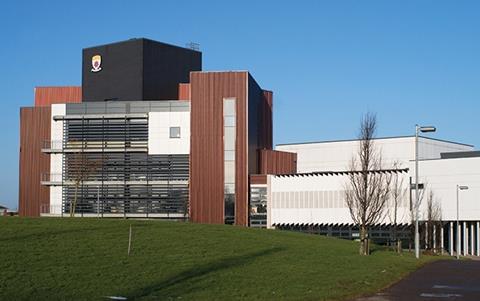You do the maths: 25% more new school places will be needed in the next five years than the previous five, yet the government is cutting overall capital funding by 16%. Continuing a series based on our Agenda 15 manifesto, Joey Gardiner finds himself stumped by the figures

It only takes a glance at social media and internet message boards aimed at parents to realise the extent of the crisis of capacity in England’s school estate. Websites like Mumsnet, which is visited by 14 million parents each week, are awash with tales of woe from worried parents despairing at getting their children places at good local schools, with threads running to hundreds of responses. One post from April 2013, from a mum who has been told she can’t get her second child into the same school as her first, is typical: “We live in a rural area and have only one car. I am expecting in November … it would be a nightmare for me to have my two older children in different schools.”
Justine Roberts, chief executive of the message board, says: “What parents really want are more good schools available to all. Too often in local areas there will only be one good school which is hugely oversubscribed. That means that the notion of choice in some areas doesn’t exist. There is too much pressure on the primary schools that are known to be good.”
It’s not surprising that parents are upset. The basic problem is a shortage of school places, which is affecting much of the country. The government estimates that between now and 2023, a total of 880,000 school places are required and, according to the Local Government Association (LGA), the problem is now so severe as to have reached a tipping point, where councils have run out of space and cash to extend schools. With huge pressure on councils to meet an immediate demand for primary places (which will turn into a big shortfall in secondary places in the next couple of years), increasing numbers are turning to short-term solutions such as temporary structures, and converting empty commercial buildings. In 2013 the then coalition government promised to give the Department for Education (DfE) £21bn of capital funding to spend on schools, colleges and universities over the course of the coming five-year parliament, and the new government is so far sticking by this figure. So does this funding give the new Conservative government a chance of meeting its pledge to offer a good primary school place for every child? Or are more parents going to face the nightmare of long school journeys and siblings at different schools?
The government’s rhetoric must be matched by its chequebook, rather than leaving local authorities to pick up the tab
David Simmonds, LGA
On the face of it £21bn sounds like an enormous amount of money, and certainly it was trumpeted by chancellor George Osborne and Treasury secretary Danny Alexander when it was announced as proof of the government’s willingness to invest in the nation’s schools. The reality is it actually represents a 16% cut on the capital funding found between 2010 and 2015. And of course this money has to do much more than just fund new school places: there is also the challenge of upgrading and replacing dilapidated schools and expanding higher education. On an annual basis, it is only just over half (54%) of what was being spent each year at the end of Labour’s last term in office.
The crisis in places has been caused by a demographic shift in the nation’s population. While the Conservatives blame the Labour administration for failing to tackle the problem when finances were less constrained, the fact is pupil numbers only started rising in 2010, with Labour’s time in office characterised by falling school rolls. Not surprisingly, perhaps, funding was targeted elsewhere. The majority of additional pupil places are presently met by extending existing school buildings, but councils will also open new schools where they can.
Despite the overall capital funding cut there are some positive signs. The Conservative Party’s election manifesto pledges to spend £7bn of the £21bn capital funding providing “good school places” over this parliament. This compares with about £5bn spent on what it calls “basic need” provision in the last five years - and therefore may imply an uplift in funding in this area, though it is not clear if the figures are directly comparable, as the £7bn may include funding for free schools.
Budget decisions taken during the last parliament have identified the first three years of this funding, to the tune of £3.6bn. To hit the promised £7bn total spend, that would leave £3.4bn to be found for the final two years - which seems unlikely. However, even at the current rate it would imply an uplift of 20%, something that would undoubtedly be welcome.
Unfortunately the good news ends there. With contractors in high demand as the economy improves, construction costs are rising fast. The RICS’ building cost information service forecasts that prices will rise by even more than the 20% uplift in funding - by 28% over the same period. Therefore it is likely that the funding identified will, at best, struggle to keep pace with inflation.
But that is the least of the difficulties. The DfE’s own pupil projection figures show that due to the impact of migration and a rising birth rate, 566,000 school places will have to be created over the course of this parliament. This is an increase of 25% on the 447,000 created over the last five years - a huge additional uplift which means the money will have to go even further. According to the LGA, £12bn is needed to fund the increase in places by 2023, which works out at £7.5bn for this parliament - more than will be allocated, to judge by both the £7bn which has been promised and the current run-rate of identified funding.

This is particularly troubling because many think the current level of funding is pretty inadequate. The LGA says local councils, which have a legal duty to provide enough places even though they no longer have direct control of many schools, have been forced to borrow money, cut back on school maintenance and abandon other building projects in order to fund the growing number of places. Last year the organisation, quoting a survey of councils, estimated the funding “black hole” at around £1bn between 2011/12 and 2016/17. This is at a time when town hall budgets have already been stripped to the bone by five years of spending austerity. The London Borough of Ealing, for example, said it borrowed £114m, made cuts of £11m to other capital budgets and pulled in £4m of Section 106 money to cover what it saw as a £129m funding shortfall for the construction of new school buildings. Overall in London, councils claim that just short of half of the cost of new places is being met by local, rather than central, government.
When the results of the LGA survey were announced David Simmonds, chairman of the LGA’s Children and Young People’s Board, said the scale of this black hole was such that the cost of the creation of new school places could not be met by council taxpayers. “The government’s rhetoric must be matched by its chequebook, rather than leaving local authorities to pick up the tab,” he said.
The National Audit Office (NAO) has also criticised the coalition for basing the funding for new school places on “incomplete information”, noting that it used out of date tender costs, failed to factor in the cost of buying land where necessary, and assumed that most new places would be met by extending existing schools. Referring to the £13,780 set aside to fund new places per child, the NAO concluded: “It is not yet clear whether this level of funding represents an accurate assessment of the resources required to meet forecast need.” Stephen Beechey, managing director of government affairs at contractor Wates, says: “The government needs to seriously review the money it is putting in to fund basic need. It’s underprovision and it’s not even dealing with the maintenance backlog either.”
This view is supported by an analysis by consultant EC Harris, which works closely with the government on its education construction programmes. Marcus Fagent, education partner at EC Harris, says the 880,000 places needed by 2023 will actually cost 50% more than the LGA estimates, if you factor in the price of land and the real cost of construction. With a total cost of over £11bn between 2015-2020, this could leave the government’s programme short by more than £4bn against currently committed funding. Fagent says the cost of expanding existing schools is increasing and there is less and less land available in urban areas for new free schools, which is increasing costs as the market price has to be paid for sites: “The government has to find more efficient ways of redeveloping land held in the public sector, such as redundant hospital sites, and will need to look at cross-funding new schools by bringing through mixed school and commercial developments,” he says.
The government needs to seriously review the money it is putting in to fund basic need. It’s under provision and it’s not even dealing with the Maintenance backlog Either
Stephen Beechey, Wates
Jonathan Stewart, managing director at Gleeds, agrees that while contractors, such as Galliford Try - which has developed a modular build system for use on school extensions - are attempting to keep costs down, there is no escaping the challenge of securing land, particularly in London where the need is most severe. According to a London Councils report, the need for new school places is running at twice the level of any other region, with 28% of all the nation’s new places needed in the capital. Stewart says: “In London, how many boroughs have excess space they can just hand over for new schools? Some do, but not many.”
For some, though, even the shortfall identified by the EC Harris analysis could be an optimistic guess, because it assumes that the new government will deliver on its promised level of funding. Former Labour construction minister Nick Raynsford says the industry should be “very nervous indeed” of the government meeting capital funding expectations, given the scale of cuts in spending likely to be required to meet its top-line financial targets. While education has been named as a department “protected” from Whitehall cuts, like health and overseas aid, this top line pledge only protects revenue funding.
Certainly there are many other priorities competing for the department’s £21bn capital pot. Not least of them is the Conservatives’ headline manifesto pledge to open 500 free schools over the course of the next parliament. EC Harris’ Fagent estimates this promise, based on the set-up costs of already approved free schools, will be somewhere in the region of £5bn. Of course, many of these free schools will be providing additional school places, and therefore will go some way to meeting “basic need”. But with no specific free school funding pot, it is unclear where the money will come from. Opponents of the programme, such as Alasdair Smith of the Anti-Academies Alliance, have already accused the government of raiding “basic need” funding to support free schools. “Because it has chosen to spend on free schools, the government doesn’t have enough to spend on local authority schools to extend them,” he says.
In addition to the pull on budgets from free schools, the previous government extended the Priority School ��ɫ����TV Programme to replace schools in the worst condition until 2021. This will require a further £2bn funding across this parliament. And for those schools not benefiting from the PSBP, there will of course need to be planned repair and maintenance work, with the government in January admitting that 95% of the nation’s school blocks require some kind of work.
So with the government pledging to increase “basic need” funding - albeit by far short of what many say is required - and ramp up the construction of free schools, it seems something will have to slip in order for it to meet its overall plan to cut education capital spend by 16%.
Meanwhile the parents out in the country beyond the corridors of Whitehall just want good quality school places for their children which do not require them to drive miles every morning, or ship siblings to different schools. On the evidence of the numbers, they may have to wait.

Schools: making it add up
��ɫ����TV’s Challenge 15 series of features takes a detailed look at the key challenges the new government must address to avoid a critical failure of the built environment to support the UK economy and society. The series is informed by ��ɫ����TV’s Agenda 15 manifesto for construction, which was published in January after a year long consultation with industry.
The manifesto, which can be viewed in full at , makes eight top line recommendations designed to help promote a more efficient, sustainable construction sector that could better deliver the UK’s built environment needs, and better help the UK economy.
On education, our recommendation for the government is for:
- A programme of construction work which both fixes the maintenance and repairs backlog as identified in the as yet unpublished property data survey, and is additionally sufficient to address the basic need for new school places. This will imply a real terms increase in capital spend above the DfE’s current £4.63bn spend.
Free schools
Since former education secretary Michael Gove launched the programme in 2010, more than 400 free schools have either opened (254) or been approved to go ahead (151). Free schools were originally conceived of as ground-up initiatives by local parents concerned about educational standards in their area, who could cut out the local authority and apply for direct government support to open a new facility. As such they were not designed to address the problem of a shortage of pupil places.
However, given concerns over the management of some early free schools, and growing fears over the shortage of places, the government has changed the policy to allow local authorities to promote free schools run by established operators of academies in areas of pupil places shortages. As there is no specific funding pot for free schools, the cost of the programme only emerges when the DfE publishes data once all contracts are completed. For free schools that opened in 2011, 2012 and 2013, the average cost of construction and land was £3.5-£4.5m. However, it is thought that costs are now rising, though more recent figures remain unpublished.
Marcus Fagent, at EC Harris, estimates the average construction cost alone of more recent free schools is around £10m. “The free schools programme has shifted from the Michael Gove vision of “pop-up” schools sponsored by parent groups to larger schools supported by established trusts. This is having the effect of creating more school places where they are most needed but is also pushing up capital costs and prices paid for land,” he says.



























No comments yet